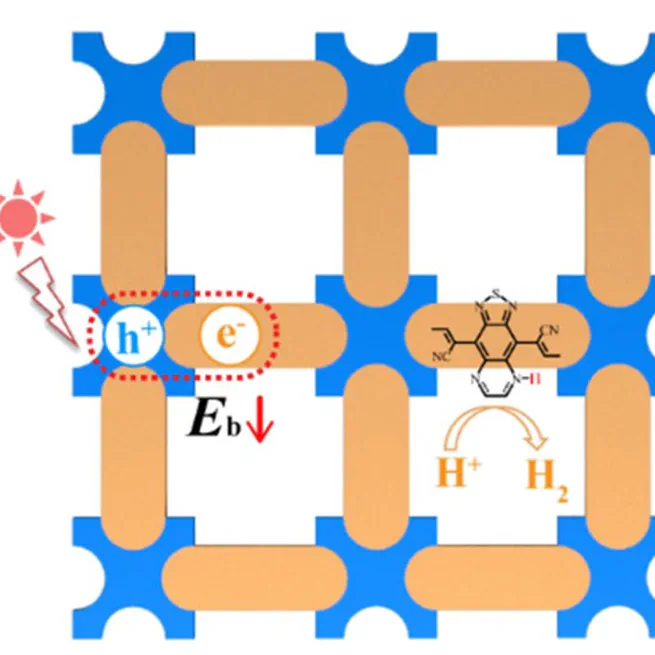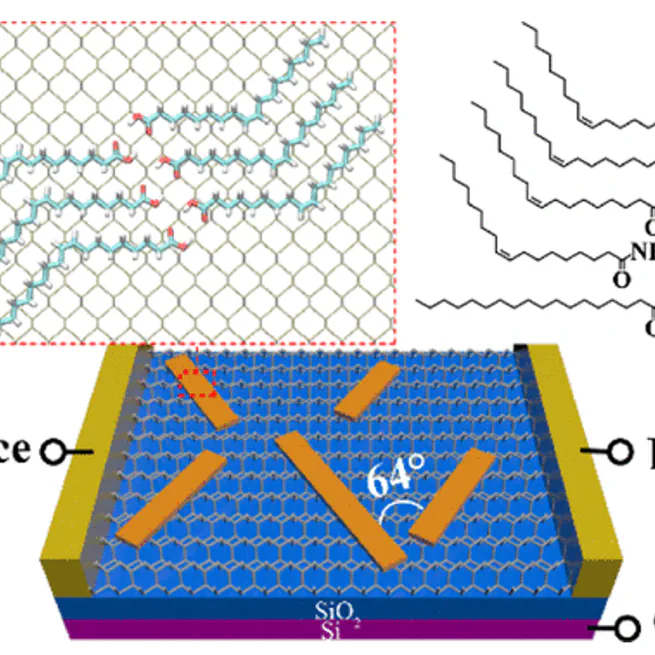
Abstract Two-dimensional conjugated covalent organic frameworks (2D c-COFs) are emerging semiconductor materials for optoelectronic and photothermal applications. In particular, the highly tailorable, semiconducting thiophene-based 2D c-COFs have attracted considerable interest due to their nontrivial physicochemical properties such as photo-activity, broad optical absorption, tunable electronic structures, and so forth. Herein, we demonstrate a novel, crystalline 2D c-COF based on thienyl-functionalized benzodithiophene (BDT) and biphenyl (BP) via the Schiff-base polycondensation reaction. The resultant BDT-BP-COF exhibits a broad optical absorption up to ca. 600 nm and decent π-conjugation along the 2D polymer skeleton, as revealed by the optical absorption and theoretical calculations. The favorable π-conjugation and the abundant electron-rich thiophene units confer excellent photo-activity to BDT-BP-COF towards the usage of solar energy. As a proof-of-concept application, we explore BDT-BP-COF in photothermal conversion, in which it shows a fast surface-temperature increase upon light irradiation for seconds.
Apr 7, 2023

Jun 22, 2022

Abstract Photocatalytic hydrogen generation is a promising solution for renewable energy production and plays a role in achieving carbon neutrality. Covalent organic frameworks (COFs) with highly designable backbones and inherent pores have emerged as novel photocatalysts, yet the strong excitonic effect in COFs can impede the promotion of energy conversion efficiency. Here, we propose a facile approach to suppress the excitonic effect in COFs, which is by narrowing the band gap and increasing the dielectric screening via a rational backbone design and chemical modifications. Based on the GW-BSE method, we uncover a linear relationship between the electronic dielectric constant and the inverse square of the optical band gap of COFs of the Lieb lattice. We further demonstrate that both reduced exciton binding energy and enhanced sunlight absorption can be simultaneously realized in COFs with a narrow band gap. Specifically, we show that one of our designed COFs whose exciton binding energy is nearly half that of g-C3N4 is capable of metal-free hydrogen production under near-infrared light irradiation. Our results showcase an effective method to suppress the excitonic effect in COFs and also pave the way for their applications in photocatalytic, photovoltaic, and other related solar energy conversions.
Jun 22, 2022
Abstract Smart materials that can respond to external stimuli are typically prepared through the coating of specific responsive ligands. Herein, for the first time, thermally reconfigurable single polyoxometalate (POM) cluster assemblies without temperature-responsive surfactants are reported. Based on transmission electron microscopy observation, POM clusters are obtained to arrange into a 2D single cluster superlattice at 25 °C, and transform themselves into a single cluster nanowire below 0 °C, which is caused by the switching of hydrogen bond linkage between clusters. Contributed by the specific coordinative state, the POM assembly exhibits excellent catalytic activity and stability toward olefin epoxidation at room temperature, demonstrating the application potentials of the nanostructures based on single clusters.
May 20, 2021
May 18, 2020

Abstract Organic and molecule-based magnets are not easily attainable, as introduction of stable paramagnetic centers to pure organic systems is particularly challenging. Crystalline covalent organic frameworks (COFs) with high designability and chemical diversity constitute ideal platforms to access intriguing magnetic phenomena of organic materials. In this work, we proposed a general approach to attain unpaired electron spin and metal-free magnetism in narrow-band COFs by chemical doping. By using density functional theory calculations, we found that dopants with energy-matched frontier orbitals to COFs not only inject charges but also further localize them through orbital hybridization and the formation of a supramolecular charge-transfer complex. The localized electronic states ensure that stable paramagnetic centers can be introduced to nonmagnetic COFs. On the basis of these discoveries, we designed two new COFs with narrow valence bands, which show prospective magnetism after doping with iodine. Further, we unraveled the magnetic anisotropy in two-dimensional COFs and demonstrated that both spin-conduction and magnetic interactions can be effectively modulated by manipulating the building blocks of COFs. Our work highlights a practical route to attain magnetism in COFs and other organic materials, which show great potential for applications in organic spintronic devices.
May 18, 2020

Abstract The precise control of the molecular position and orientation of its nanoscale assembly on atomic crystals is pivotal for fabricating hybrid organic/inorganic van der Waals heterostructures with targeted functionalities. Recently, we observed the assembly of oleamide into nanoribbons, orienting exclusively along a crystallographic direction on a variety of atomic crystals. Motivated by this observation, we designed a series of long-chain alkanes, alkenes, and their derivatives with −OH, −COOH, and −CONH2 terminal groups to unveil how chemical units regulate the orientation of suparamolecular assembly by density functional theory calculations. We found that the cis-C═C bond can increase the rigidity of long alkyl chains, tailoring angles and van der Waals interactions between them, while the −CONH2 group facilitates intermolecular hydrogen bonds. Either of these two moieties is required for the oriented assembly on both hexagonal and orthorhombic atomic lattices. We predicted that nanoribbons formed by long-chain cis-alkene and derivatives orient along the zigzag direction on graphene and 32° deflected from the armchair direction on black phosphorene, which were supported by the experiment. The fundamental understandings toward the chemical group regulated intermolecular interactions, and their interplay in the oriented supramolecular assembly is expected to substantially expedite the design and controlled synthesis of organic/inorganic van der Waals heterostructures using the bottom-up method.
Nov 27, 2019

Abstract The assembly of atomically precise clusters into superstructures has tremendous potential in structural tunability and applications. Here, we report a series of single-cluster nanowires, single-cluster nanorings, and three-dimensional superstructure assemblies built by POM clusters. By stepwise tuning of interactions at molecular levels, the configurations can be varied from single-cluster nanowires to nanorings. A series of single-cluster nanostructures in different configurations can be achieved with up to 15 kinds of POM clusters. The single-cluster nanowires and three-dimensional superstructures perform enhanced activity in the catalytic and electrochemical sensing fields, illustrating the universal functionality of single-cluster assemblies.
Jul 26, 2019

Abstract Two-dimensional (2D) transition metal dichalcogenides (TMDCs) with layered structures provide a unique platform for exploring the effect of number of layers on their fundamental properties. However, the thickness scaling effect on the chemical properties of these materials remains unexplored. Here, we explored the chemically induced phase transition of 2D molybdenum disulfide (MoS2) from both experimental and theoretical aspects and observed that the critical electron injection concentration and the duration required for the phase transition of 2D MoS2 increased with decreasing number of layers. We further revealed that the observed dependence originated from the layer-dependent density of states of 2H-MoS2, which results in decreasing phase stability for 2H-MoS2 with increasing number of layers upon electron doping. Also, the much larger energy barrier for the phase transition of monolayer MoS2 induces the longer reaction time required for monolayer MoS2 as compared to multilayer MoS2. The layer-dependent phase transition of 2D MoS2 allows for the chemical construction of semiconducting-metallic heterophase junctions and, subsequently, the fabrications of rectifying diodes and all 2D field effect transistors and thus opens a new avenue for building ultrathin electronic devices. In addition, these new findings elucidate how electronic structures affect the chemical properties of 2D TMDCs and, therefore, shed new light on the controllable chemical modulations of these emerging materials.
May 21, 2018
![Supramolecular catalyst functions in catalytic amount: cucurbit[8]uril accelerates the photodimerization of Brooker’s merocyanine](/publication/2017-10-13-c-chemicalscience/featured_hu12590774283346012521.webp)
Abstract Supramolecular catalysis aims to modulate chemical reactions on both selectivity and rate by taking advantage of supramolecular chemistry. However, due to the effect of product inhibition, supramolecular catalysts are usually added in stoichiometric amounts. Herein, we report a supramolecular catalysis system in which 1% of the supramolecular catalyst, cucurbit[8]uril, is able to significantly accelerate the photodimerization of Brooker’s merocyanine. This catalytic process is realized in a cyclic manner because the photodimerized product can be spontaneously replaced by monomeric reactants via competitive host–guest complexation. Thus, a catalytic amount of cucurbit[8]uril is sufficient to accomplish photodimerization within 10 min. This line of research will enrich the field of supramolecular catalysis and allow the development of more efficient catalytic systems.
Oct 13, 2017